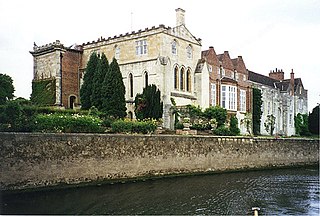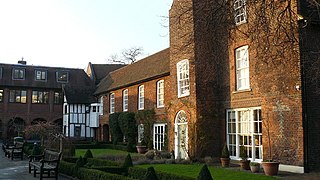
The Archbishop's Palace was the residence of the Archbishop of York during the later Middle Ages. It lay immediately north of York Minster, and its grounds are now known as Dean's Park.

The Archbishop's Palace was the residence of the Archbishop of York during the later Middle Ages. It lay immediately north of York Minster, and its grounds are now known as Dean's Park.
York Minster was severely damaged by a fire in 1137. Roger de Pont L'Évêque, Archbishop of York from 1154 to 1181, rebuilt the minster, and appears to have also begun the construction of the palace. In 1179, the college and chapel of St Mary and All Angels, also known as St Sepulchre, was built next to the palace, and the history of the structure became intertwined. In 1268, the grounds of the palace were extended up to the city walls. [1] [2]
The palace was used for a wide variety of purposes. The justices of oyer and terminer sat there in 1275, while in 1327–1328, Edward III of England based his court at the palace while he was leading a campaign against the Scots; the palace was altered at great expense to host him. By 1385, it also housed the archbishop's prison, probably in the crypt below St Sepulchre's Chapel. In 1400, a new chamber was added from which Henry IV of England could watch a tournament being held in the palace grounds. Richard III of England stayed at the palace in 1483, as did Henry VII of England in 1487, and Margaret Tudor in 1503. [1]

St Sepulchre's College was dissolved in 1547, [2] while in the 1560s, Thomas Young removed the lead from the palace's roof. This was supposedly to purchase Grays Court for his son, George, the building probably being extended in part with stone taken from the palace. By 1616, the palace was in ruins, and the grounds were sold to Arthur Ingram. He rebuilt part of the palace as his own house, and laid out gardens in the remainder of the grounds, which include a fishpond, tennis court and bowling green. Charles I of England stayed in the house in 1642, but after Ingram's death, his descendants divided the property into small tenements and let them out. [1]

In 1734, a theatre was built on the site of the tennis court. In 1780, the former great hall of the palace was rebuilt as a riding school, noted in 1785 as the site of an early balloon ascent. In 1799, a panorama depicting the Royal Navy at the Spithead review was displayed in the building. By this time, Ingram's house was largely in ruins. York Minster purchased the whole site in 1814, and demolished Ingram's house, using the site for its stone yard, and also demolished the riding school. The palace's former chapel was restored for use as the minster library, and is now known as the Old Palace. In 1823, the remainder of the site was again laid out as the Deanery Gardens. Demolition of some sheds revealed a 12th-century arcade from the original palace. [2]
More recently, the grounds have become known as Dean's Park, and the stone yard has moved to Deangate. During World War II, the park was excavated to house water tanks, but it has since been restored. In 1987, the arcade was rededicated as a war memorial to the dead of the world wars and 19th-century conflicts, and since 1997, it has been grade I listed. [2] [3]

The Cathedral and Metropolitical Church of Saint Peter in York, commonly known as York Minster, is an Anglican cathedral in York, North Yorkshire, England, and is one of the largest of its kind in Northern Europe. The minster is the seat of the Archbishop of York, the third-highest office of the Church of England, and is the mother church for the Diocese of York and the Province of York. It is administered by its Dean and chapter. The title "minster" is attributed to churches established in the Anglo-Saxon period as missionary teaching churches, and serves now as an honorific title; the word Metropolitical in the formal name refers to the Archbishop of York's role as the Metropolitan bishop of the Province of York. Services in the minster are sometimes regarded as on the High Church or Anglo-Catholic end of the Anglican continuum.

Bishopthorpe Palace is a historic house at Bishopthorpe, to the south of York, in the City of York unitary authority and ceremonial county of North Yorkshire, England. It is situated on the River Ouse and is the official residence of the Archbishop of York. In the local area it is known as "the Archbishop's Palace".

Gisborough Priory is a ruined Augustinian priory in Guisborough in the current borough of Redcar and Cleveland, North Yorkshire, England. It was founded in 1119 as the Priory of St Mary by the Norman feudal magnate Robert de Brus, also an ancestor of the Scottish king, Robert the Bruce. It became one of the richest monastic foundations in England with grants from the crown and bequests from de Brus, other nobles and gentry and local people of more modest means. Much of the Romanesque Norman priory was destroyed in a fire in 1289. It was rebuilt in the Gothic style on a grander scale over the following century. Its remains are regarded as among the finest surviving examples of early Gothic architecture in England.

The Palace of Whitehall – also spelled White Hall – at Westminster was the main residence of the English monarchs from 1530 until 1698, when most of its structures, with the notable exception of Inigo Jones's Banqueting House of 1622, were destroyed by fire. Henry VIII moved the royal residence to White Hall after the old royal apartments at the nearby Palace of Westminster were themselves destroyed by fire. Although the Whitehall palace has not survived, the area where it was located is still called Whitehall and has remained a centre of the British government.
William of York was an English priest and twice Archbishop of York, before and after a rival, Henry Murdac. He was thought to be related to King Stephen of England, who helped to secure his election to the province after several candidates had failed to gain papal confirmation. William faced opposition from the Cistercians, who after the election of the Cistercian Pope Eugene III, had William deposed in favour of a Cistercian, Murdac. From 1147 until 1153, William worked to be restored to York, which he achieved after the deaths of Murdac and Eugene III. He did not hold the province long, dying shortly after his return, allegedly from poison in the chalice he used to celebrate Mass. Miracles were reported at his tomb from 1177. He was canonised in 1226.

Croydon Palace, in Croydon, now part of south London, was the summer residence of the Archbishop of Canterbury for over 500 years. Regular visitors included Henry III and Queen Elizabeth I. Now known as Old Palace, the buildings are still in use as the Old Palace School, an independent girls' school of the Whitgift Foundation. It has been a grade I listed building since 1951.
York had around 45 parish churches in 1300. Twenty survive, in whole or in part, a number surpassed in England only by Norwich, and 12 are used for worship. This article consists of a list of medieval churches which still exist in whole or in part, and a list of medieval churches which are known to have existed in the past but have been completely demolished.

Howden Minster is a large Grade I listed Church of England church in the Diocese of York. It is located in Howden, East Riding of Yorkshire, England and is one of the largest churches in the East Riding. It is dedicated to St Peter and St Paul and it is therefore properly known as 'the Minster Church of St Peter and St Paul'. Its Grade I listed status also includes the Chapter House.

Hyde Abbey was a medieval Benedictine monastery just outside the walls of Winchester, Hampshire, England. It was dissolved and demolished in 1538 following various acts passed under King Henry VIII to dissolve monasteries and abbeys. The Abbey was once known to have housed the remains of King Alfred the Great, his son, King Edward the Elder, and his wife, Ealhswith. Following its dissolution these remains were lost; however, excavations of the Abbey and the surrounding area continue.

English Gothic is an architectural style that flourished from the late 12th until the mid-17th century. The style was most prominently used in the construction of cathedrals and churches. Gothic architecture's defining features are pointed arches, rib vaults, buttresses, and extensive use of stained glass. Combined, these features allowed the creation of buildings of unprecedented height and grandeur, filled with light from large stained glass windows. Important examples include Westminster Abbey, Canterbury Cathedral and Salisbury Cathedral. The Gothic style endured in England much longer than in Continental Europe.

Drypool is an area within the city of Kingston upon Hull, England.


St Augustine's Abbey was a Benedictine monastery in Canterbury, Kent, England. The abbey was founded in 598 and functioned as a monastery until its dissolution in 1538 during the English Reformation. After the abbey's dissolution, it underwent dismantlement until 1848.

The Cheddar Palace was established in the 9th century, in Cheddar, Somerset, England. It was a royal hunting lodge in the Anglo-Saxon and medieval periods and hosted the Witenagemot in the 10th century.

The following is a timeline of the history of the city of York, North Yorkshire in northern England.

Hillfield Gardens is a public park on London Road, Gloucester, England. It houses several historical monuments. The description in December 2020 stated: "Now a Council-owned public park covering about 1.6 hectares, Highfield Gardens is supported by an active Friends group which organises annual events".

St Mary's Church is an Anglican parish church in Beverley in the East Riding of Yorkshire, England. It is designated a Grade I listed building.

Dean's Park is an urban park in York, England. It was created in the 19th century.

Bedern is a street in the city centre of York, in England, which originated as a college for the vicars choral of York Minster.

Minster Yard is a street in the city centre of York, England. It runs along the southern, eastern and northeastern sides of York Minster, for which it is named.